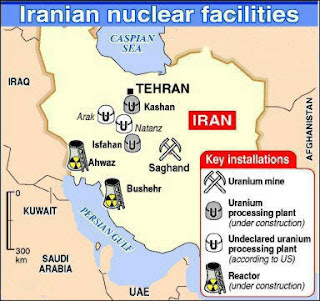Is Iranian nuclear game boxing or chess?

What direction does the Iranian nuclear program have? The country really needs nuclear energy given Iranian energy needs increasing 11 percent. Official Tehran has developed the program to transform nuclear energy into electricity, with total capacity of 20,000 megawatts within twenty-year plan. But the question is whether the implementation of this plan is real.
At least 20 plants for enriching uranium by 3,5-5 percent on an industrial scale are necessary to produce this amount of electricity. Moreover, about 54,000 active centrifuges must operate at each plant without fail.
At present, Iran has installed only 9,000 centrifuges at the enrichment plant at Natanz, half of which are inactive. This plant is able to enrich up to 2 kilograms of 3.5-percent enriched uranium per day, that is, this plant will enrich the 700 kilograms of uranium if it has "Yellow Cake". Taking into account that only 9,000 have been installed during Ahmadinejad's five-year taking office, half of which are inactive, it is difficult to determine the launch date of 54,000 centrifuges.
In late November the head of the Atomic Energy Organization of Iran, Ali Akbar Salehi, said that another 10 centers for uranium enrichment will be constructed under the decree of Iranian President Mahmoud Ahmadinejad. He said that these power plants will be similar with the center in Natanz by capacity and will be built among mountains to protect against missile attacks. Thus, Iran should launch half a million of centrifuges, but given that the country today is not able to do it and the fact that Iran has to import some parts of centrifuges, consisting of 120 components, the implementation of this plan is possible only at a theoretical level. In any case, the UN Security Council adopted five resolutions against Iran's nuclear program and imposed a ban on the import and export of uranium, the sale of nuclear technology and any assistance related to this program.
On the other hand, reserves and the number of uranium deposits in Iran are limited. There are insufficient reserves of uranium in the deposits Saghand and Gahan to produce 1,400 tons of "yellow cake", i.e the country will not be able to provide even the annual need of the nuclear power plant in uranium, commensurate with the power plant at Bushehr (1,000 megawatts).
UN ex-head and head of research center associated with the proliferation of nuclear weapons, David Albright, presented the report in February 2009. The report states that the images from the satellite, made in 2004-2008 showed that no operations were made in fields Saghand and Gahan. Perhaps, Iran is still using 600 tons of "yellow cake", bought in South Africa in 1970. According to the ISIS's report, Iran has used 75 percent of 600-ton yellow cake.
Certainly, Iran can import uranium from Venezuela and Bolivia. Venezuelan President Hugo Chavez said that Tehran will take part in the development of uranium deposits in Venezuela. Moreover, there are rich deposits of uranium in the east of Bolivia, which is the enemy of the United States and close ally of the Islamic republic. But the UN Security Council resolutions imposed a ban on the sale of uranium to Iran. Tehran can also receive 50,000 tons of raw uranium per year from the fields Saghand and Gahan. It does not comply with the plan, envisaging the production of 20,000 megawatts of nuclear electricity.
The IAEA ex-head Mohammed ElBaradei, has repeatedly said that he was not fully confident about the peaceful nature of Iran's nuclear program. But at the same time he emphasized that there is no evidence concerning official Tehran's development of nuclear weapons.
Despite the production of 520 million cubic meters of gas per day, Iran's need for fuel increases 9 percent every year. It testifies that the country extremely needs development of nuclear energy. However, the politicization of this issue from both Iran and the West led to the escalation of tensions. The IAEA board of governors adopted the resolution on Nov. 27. It contains a condemnation of Iran for the construction of uranium enrichment plant near the city of Qom and the requirement to immediately quit this project. In response, official Tehran made a statement to build 10 more plants for uranium enrichment.

Comments
Post a Comment